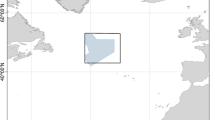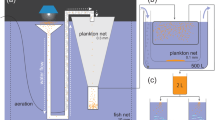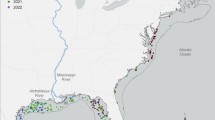Abstract
Very little is known on the sources and movements of the potentially fatal cubomedusae Chironex fleckeri found around estuary mouths and beaches along tropical coastlines of Australia. Largely anecdotal evidence suggests an alternating season of polyps in protected estuaries during the dry season and medusae emerging from estuaries to feed along beaches with the onset of the monsoonal season. An experiment was conducted on young wild-caught C. fleckeri medusae (caught at Cape York, Australia, in November 2012) to establish how elemental incorporation into statoliths was affected by salinity. A critical salinity test revealed medusae inhabit salinities >20. Medusae were held in salinities of 22, 26, 30 and 34 (n = 5 per treatment) for a duration of 4 days. Laser ablation inductively coupled plasma mass spectrometry was used to analyse experimental areas of statoliths and solution-based ICPMS used for analysing water samples taken from each treatment. Statolith Mg Ca−1 and the partition coefficient (D Mg) significantly differed among treatments and were the only element Ca−1 ratios to do so. Multi-element Ca−1 signatures could also discriminate among salinity treatments. Partition coefficients revealed D Mg, D Sr and D Li were 2.62 × 10−6–0.81 and D Ba, D Mn and D Zn 1.87–431. Experimental and strong correlative evidence suggested that temperature exposure and not salinity was responsible for the significant patterns seen in statolith Sr Ca−1 found by Mooney and Kingsford (2012). Statolith chemistry shows strong promise for determining the movement of medusae through water bodies where there are known thermal and salinity gradients.





Similar content being viewed by others
References
Bailey PM, Little M, Jelinek GA, Wilce JA (2003) Jellyfish envenoming syndromes: unknown toxic mechanisms and unproven therapies. Med J Aust 178:34–37
Bath GE, Thorrold SR, Jones CM, Campana SE, McLaren JW, Lam JWH (2000) Strontium and barium uptake in aragonitic otoliths of marine fish. Geochim Cosmochim Acta 64:1705–1714. doi:10.1016/S0016-7037(99)00419-6
Campana SE (1999) Chemistry and composition of fish otoliths: pathways, mechanisms and applications. Mar Ecol Prog Ser 188:263–297. doi:10.3354/meps188263
Carrette T, Alderslade P, Seymour J (2002) Nematocyst ratio and prey in two Australian cubomedusans, Chironex fleckeri and Chiropsalmus sp. Toxicon 40:1547–1551. doi:10.1016/S0041-0101(02)00168-X
Cimino G, Alfa M, La Spada G (1983) Trace elements in tentacles from the jellyfish Pelagia noctiluca. Mar Pollut Bull 14:197–198. doi:10.1016/0025-326X(83)90232-1
Cohen J (1988) Statistical power analysis for the behavioural sciences. Lawrence Erlbaum, Hillsdale
Colin SP, Costello JH, Katija K, Seymour J, Kiefer K (2013) Propulsion in cubomedusae: mechanisms and utility. PLoS One 8(2):e56393. doi:10.1371/journal.pone.0056393
Daverat F, Tomas J, Lahaye M, Palmer M, Elie P (2005) Tracking continental habitat shifts of eels using otolith Sr/Ca ratios: validation and application to the coastal, estuarine and riverine eels of the Gironde–Garonne–Dordogne watershed. Mar Freshw Res 56:619–627. doi:10.1071/MF04175
De Vries MC, Gillanders BM, Elsdon TS (2005) Facilitation of barium uptake into fish otoliths: influence of strontium concentration and salinity. Geochim Cosmochim Acta 69:4061–4072. doi:10.1016/j.gca.2005.03.052
Elsdon TS, Gillanders BM (2005) Consistency of patterns between laboratory experiments and field collected fish in otolith chemistry: an example and applications for salinity reconstructions. Mar Freshw Res 56:609–617. doi:10.1071/MF04146
Ferguson JE, Henderson GM, Kucera M, Rickaby REM (2008) Systematic change of foraminiferal Mg/Ca ratios across a strong salinity gradient. Earth Planet Sci Lett 265:153–166. doi:10.1016/j.epsl.2007.10.011
Gallahar NK, Kingsford MJ (1996) Factors influencing Sr/Ca ratios in otoliths of Girella elevata: an experimental investigation. J Fish Biol 48:174–186. doi:10.1111/j.1095-8649.1996.tb01111.x
Glass GV, Peckham PD, Sanders JR (1972) Consequences of failure to meet assumptions underlying the fixed effects analysis of variance and covariance. Rev Educ Res 42:237–288
Gordon M, Seymour J (2012) Growth, development and temporal variation in the onset of six Chironex fleckeri medusae seasons: a contribution to understanding jellyfish ecology. PLoS One 7(2):e31277. doi:10.1371/journal.pone.0031277
Gordon M, Hatcher C, Seymour J (2004) Growth and age determination of the tropical Australian cubozoan Chiropsalmus sp. Hydrobiologia 530(531):339–345. doi:10.1007/s10750-004-2655-7
Hamner WM, Jones MS, Hamner PP (1995) Swimming, feeding, circulation and vision in the Australian box jellyfish, Chironex fleckeri (Cnidaria: Cubozoa). Mar Freshw Res 46:985–990. doi:10.1071/MF9950985
Hartwick RF (1991) Distributional ecology and behaviour of the early life stages of the box-jellyfish Chironex fleckeri. Hydrobiologia 216(217):181–188. doi:10.1007/978-94-011-3240-4_25
Jack L, Wing SR, Hu Y, Roberts M (2011) Natural trace elemental markers for adult red rock lobsters Jasus edwardsii vary among replicate distinct water masses. Mar Ecol Prog Ser 443:141–151. doi:10.3354/meps09510
Jacups SP (2010) Warmer waters in the northern territory-herald an earlier onset to the annual Chironex fleckeri stinger season. EcoHealth 7:14–17. doi:10.1007/s10393-010-0306-1
Kawamura M, Ueno S, Iwanaga S, Oshiro N, Kubota S (2003) The relationship between fine rings in the statolith and growth of the cubomedusa Chiropsalmus quadrigatus (Cnidaria: Cubozoa) from Okinawa Island, Japan. Plankton Biol Ecol 50:37–42
Kingsford MJ, Mooney CJ (2014) The ecology of box jellyfishes (Cubozoa). In: Pitt KA, Lucas CH (eds) Jellyfish blooms. Springer, Netherlands, pp 267–302. doi:10.1007/978-94-007-7015-7_12
Kingsford MJ, Hughes JM, Patterson HM (2009) Otolith chemistry of the non-dispersing reef fish Acanthochromis polyacanthus: cross-shelf patterns from the central Great Barrier Reef. Mar Ecol Prog Ser 377:279–288. doi:10.3354/meps07794
Kingsford MJ, Seymour JE, O’Callaghan MD (2012) Abundance patterns of cubozoans on and near the Great Barrier Reef. Hydrobiologia 690:257–268. doi:10.1007/s10750-012-1041-0
Kraus RT, Secor DH (2004) Incorporation of strontium into otoliths of an estuarine fish. J Exp Mar Biol Ecol 302:85–106. doi:10.1016/j.jembe.2003.10.004
Marshall JF, McCulloch MT (2002) An assessment of the Sr/Ca ratio in shallow water hermatypic corals as a proxy for sea surface temperature. Geochim Cosmochim Acta 66:3263–3280. doi:10.1016/S0016-7037(02)00926-2
Martin GB, Thorrold SR (2005) Temperature and salinity effects on magnesium, manganese, and barium incorporation in otoliths of larval and early juvenile spot Leiostomus xanthurus. Mar Ecol Prog Ser 293:223–232. doi:10.3354/meps293223
Martin GB, Thorrold SR, Jones CM (2004) Temperature and salinity effects on strontium incorporation in otoliths of larval spot (Leiostomus xanthurus). Can J Fish Aquat Sci 61:34–42. doi:10.3354/meps293223
McClounan S, Seymour J (2012) Venom and cnidome ontogeny of the cubomedusae Chironex fleckeri. Toxicon 60:1335–1341. doi:10.1016/j.toxicon.2012.08.020
McCulloch M, Cappo M, Aumend J, Müller W (2005) Tracing the life history of individual barramundi using laser ablation MC-ICP-MS Sr-isotopic and Sr/Ba ratios in otoliths. Mar Freshw Res 56:637–644. doi:10.1071/MF04184
Miles NG, West RJ, Norman MD (2009) Does otolith chemistry indicate diadromous lifecycles for five Australian riverine fishes? Mar Freshw Res 60:904–911. doi:10.1071/MF08252
Mooney CJ, Kingsford MJ (2012) Sources and movements of Chironex fleckeri medusae using statolith elemental chemistry. Hydrobiologia 690:269–277. doi:10.1007/s10750-012-1049-5
Morse JW, Bender ML (1990) Partition coefficients in calcite: examination of factors influencing the validity of experimental results and their application to natural systems. Chem Geol 82:265–277. doi:10.1016/0009-2541(90)90085-L
Nilsson DE, Gislén L, Coates MM, Skogh C, Garm A (2005) Advanced optics in a jellyfish eye. Nature 435:201–205. doi:10.1038/nature03484
Paton C, Hellstrom J, Paul B, Woodhead J, Hergt J (2011) Iolite: freeware for the visualisation and processing of mass spectrometric data. J Anal At Spectrom 26:2508–2518. doi:10.1039/C1JA10172B
Phillis CC, Ostrach DJ, Ingram BL, Weber PK (2011) Evaluating otolith Sr/Ca as a tool for reconstructing estuarine habitat use. Can J Fish Aquat Sci 68:360–373. doi:10.1139/F10-152
Sadovy Y, Severin KP (1992) Trace elements in biogenic aragonite: correlation of body growth rate and strontium levels in the otoliths of the white grunt, Haemulon plumieri (Pisces: Haemulidae). Bull Mar Sci 50:237–257
Sanchez-Jerez P, Gillanders BM, Kingsford MJ (2002) Spatial variability of trace elements in fish otoliths: comparison with dietary items and habitat constituents in seagrass meadows. J Fish Biol 60:801–821. doi:10.1111/j.1095-8649.2002.tb00912.x
Secor DH, Henderson-Arzapalo A, Piccoli PM (1995) Can otolith microchemistry chart patterns of migration and habitat utilisation in anadromous fishes? J Exp Mar Biol Ecol 192:15–33. doi:10.1016/0022-0981(95)00054-U
Seymour JE, Carrette TJ, Sutherland PA (2004) Do box jellyfish sleep at night? Med J Aust 181:707
Sötje I, Neues F, Epple M, Ludwig W, Rack A, Gordon M, Boese R, Tiemann H (2011) Comparison of the statolith structures of Chironex fleckeri (Cnidaria, Cubozoa) and Periphylla periphylla (Cnidaria, Scyphozoa): a phylogenetic approach. Mar Biol 158:1149–1161. doi:10.1007/s00227-011-1637-3
Strasser CA, Mullineaux LS, Thorrold SR (2008) Temperature and salinity effects on elemental uptake in the shells of larval and juvenile softshell clams Mya arenaria. Mar Ecol Prog Ser 370:155–169. doi:10.3354/meps07658
Tabouret H, Bareille G, Claverie F, Pécheyran C, Prouzet P, Donard OFX (2010) Simultaneous use of strontium:calcium and barium:calcium ratios in otoliths as markers of habitat: application to the European eel (Anguilla anguilla) in the Adour basin, South West France. Mar Environ Res 70:35–45. doi:10.1016/j.marenvres.2010.02.006
Tanner SE, Reis-Santos P, Vasconcelos RP, Fonseca VF, Franca S, Cabral HN, Thorrold SR (2013) Does otolith geochemistry record ambient environmental conditions in a temperate tidal estuary? J Exp Mar Biol Ecol 441:7–15. doi:10.1016/j.jembe.2013.01.009
Templeman MA, Kingsford MJ (2010) Trace element accumulation in Cassiopea sp. (Scyphozoa) from urban marine environments in Australia. Mar Environ Res 69:63–72. doi:10.1016/j.marenvres.2009.08.001
Templeman MA, Kingsford MJ (2012) Variation in soft tissue chemistry among scyphozoan and cubozoan jellyfishes from the Great Barrier Reef, Australia. Hydrobiologia 690:279–290. doi:10.1007/s10750-012-1051-y
Thébault J, Chauvaud L, L’Helguen S, Clavier J, Barats A, Jacquet S, Pécheyran C, Amouroux D (2009) Barium and molybdenum records in bivalve shells: geochemical proxies for phytoplankton dynamics in coastal environments? Limnol Oceanogr 54(3):1002–1014. doi:10.4319/lo.2009.54.3.1002
Tibballs J (2006) Australian venomous jellyfish, envenomation syndromes, toxins and therapy. Toxicon 48:830–859. doi:10.1016/j.toxicon.2006.07.020
Tiemann H, Sötje I, Becker A, Jarms G, Epple M (2006) Calcium sulfate hemihydrate (bassanite) statoliths in the cubozoan Carybdea sp. Zool Anz 245:13–17. doi:10.1016/j.jcz.2006.03.001
Tzeng WN (1996) Effects of salinity and ontogenetic movements on strontium: calcium ratios in the otoliths of Japanese eel, Anguilla japonica Temminick and Schlegel. J Exp Mar Biol Ecol 199:111–122. doi:10.1016/0022-0981(95)00185-9
Ueno S, Imai C, Mitsutani A (1995) Fine growth rings found in statolith of a cubomedusa Carybdea rastonii. J Plankton Res 17:1381–1384. doi:10.1093/plankt/17.6.1381
Underwood AJ (1997) Experiments in ecology: their logical design and interpretation using analysis of variance. Cambridge University Press, Cambridge 504 pp
Walther BD, Kingsford MJ, O’Callaghan MD, McCulloch MT (2010) Interactive effects of ontogeny, food ration and temperature on elemental incorporation in otoliths of a coral reef fish. Environ Biol Fish 89:441–451. doi:10.1007/s10641-010-9661-6
Wang CH (2014) Otolith elemental ratios of flathead mullet Mugil cephalus in Taiwanese waters reveal variable patterns of habitat use. Estuar Coast Shelf Sci 151:124–130. doi:10.1016/j.ecss.2014.08.024
Watanabe T, Kiron V, Satoh S (1997) Trace minerals in fish nutrition. Aquaculture 151:185–207. doi:10.1016/S0044-8486(96)01503-7
Watson EB (1996) Surface enrichment and trace-element uptake during crystal growth. Geochim Cosmochim Acta 60(24):5013–5020. doi:10.1016/S0016-7037(96)00299-2
Woodhead JD, Hellstrom J, Hergt JM, Greig A, Maas R (2007) Isotopic and elemental imaging of geological materials by laser ablation Inductively Coupled Plasma-mass spectrometry. Geostand Geoanal Res 31:331–343. doi:10.1111/j.1751-908X.2007.00104.x
Zacherl DC, Manríquez PH, Paradis G, Day RW, Castilla JC, Warner RR, Lea DW, Gaines SD (2003) Trace elemental fingerprinting of gastropod statoliths to study larval dispersal trajectories. Mar Ecol Prog Ser 248:297–303. doi:10.3354/meps248297
Zumholz K, Hansteen TH, Piatkowski U, Croot PL (2007) Influence of temperature and salinity on the trace element incorporation into statoliths of the common cuttlefish (Sepia officinalis). Mar Biol 151:1321–1330. doi:10.1007/s00227-006-0564-1
Acknowledgments
We would like to thank volunteers Mark O’Callaghan and Avril Underwood for assistance in Weipa, Yi Hu at AAC for assistance with SO-ICPMS and Townsville Lifeguard Service for provision of some statoliths from the Strand, Townsville. This research was supported by a grant from the Australian Lions Foundation to CJM. We also thank Queensland Boating and Fisheries Patrol, Fisheries Queensland for use of their Evans Landing facility to conduct the experiment.
Author information
Authors and Affiliations
Corresponding author
Additional information
Responsible Editor: A. Checa.
Reviewed by Undisclosed experts.
Rights and permissions
About this article
Cite this article
Mooney, C.J., Kingsford, M.J. The influence of salinity on box jellyfish (Chironex fleckeri, Cubozoa) statolith elemental chemistry. Mar Biol 163, 103 (2016). https://doi.org/10.1007/s00227-016-2867-1
Received:
Accepted:
Published:
DOI: https://doi.org/10.1007/s00227-016-2867-1




